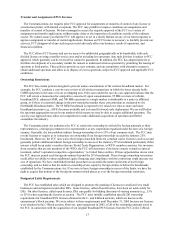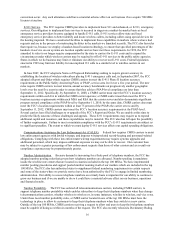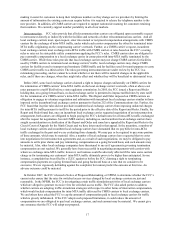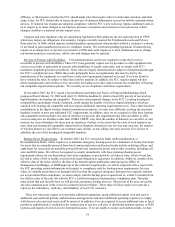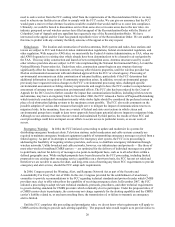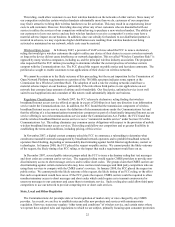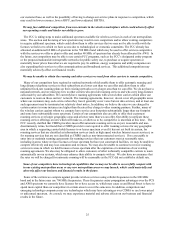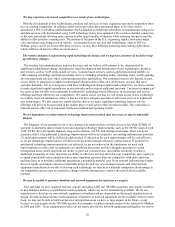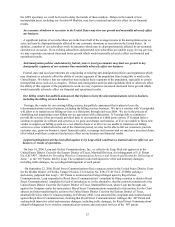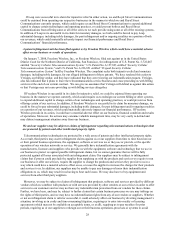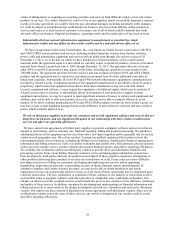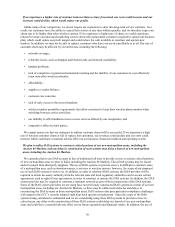Metro PCS 2007 Annual Report Download - page 31
Download and view the complete annual report
Please find page 31 of the 2007 Metro PCS annual report below. You can navigate through the pages in the report by either clicking on the pages listed below, or by using the keyword search tool below to find specific information within the annual report.
20
need to seek a waiver from the FCC seeking relief from the requirements of the Reconsideration Order or we may
need to relocate our facilities in an effort to comply with the FCC’ s rules. We can give no assurance that the FCC
would grant a waiver or that alternate locations would be available that would enable us to come into compliance.
Ultimately, we could be forced to discontinue service from some sites or in some areas due to the new rules. An
industry group and several wireless carriers have filed an appeal of the Reconsideration Order with the District of
Columbia Court of Appeals and one appellant has requested a stay of the Reconsideration Order. We have
intervened in the appeal and the Court has granted expedited review of the Reconsideration Order. We are unable at
this time to predict with any certainty the likely outcome of the appeal or the stay request.
Siting Issues. The location and construction of wireless antennas, DAS systems and nodes, base stations and
towers are subject to FCC and Federal Aviation Administration regulations, federal environmental regulation, and
other regulation. With respect to AWS sites, we must notify the Federal Aviation Administration, or FAA, when we
add AWS frequencies to existing sites which already have been determined not to be a hazard to air navigation by
the FAA. This may delay construction and launch of new metropolitan areas. Antenna structures used by us and
other wireless providers also are subject to FCC rules implementing the National Environmental Policy Act and the
National Historic Preservation Act. Under these rules, construction cannot begin on any structure that may
significantly affect the human environment, or that may affect historic properties, until the wireless provider has
filed an environmental assessment with and obtained approval from the FCC or a local agency. Processing of
environmental assessments can delay construction of antenna facilities, particularly if the FCC determines that
additional information is required or if community opposition arises. In addition, several environmental groups
previously have requested various changes to the FCC’ s environmental processing rules, challenged specific
environmental assessments as failing statutory requirements and sought to have the FCC conduct a comprehensive
assessment of antenna tower construction environmental effects. The FCC also has been ordered by the Court of
Appeals for the DC Circuit to further consider the impact that communications facilities, including wireless towers
and antennas, may have on migratory birds. In November 2006, the FCC released a Notice of Proposed Rulemaking
which tentatively concludes that medium-intensity white strobe lights should be considered the preferred system in
place of red obstruction lighting systems to the maximum extent possible. The FCC also seeks comments on the
possible adoption of various other measures that might serve to mitigate the impact of communications towers on
migratory birds. In the meantime, there are a variety of federal and state court actions in which citizen and
environmental groups have sought to deny tower approvals based upon potential adverse impacts to migratory birds.
Although we use antenna structures that are owned and maintained by third parties, the results of these FCC and
court proceedings could have an impact on our efforts to secure access to particular towers, or on our costs of
access.
Emergency Warning. In 2004, the FCC initiated a proceeding to update and modernize its systems for
distributing emergency broadcast alerts. Television stations, radio broadcasters and cable systems currently are
required to maintain emergency broadcast equipment capable of retransmitting emergency messages received from a
federal agency. As part of its attempts to modernize the emergency alert system, the FCC in its proceeding is
addressing the feasibility of requiring wireless providers, such as us, to distribute emergency information through
wireless networks. Unlike broadcast and cable networks, however, our infrastructure and protocols — like those of
most other wireless broadband CMRS carriers — are optimized for the delivery of individual messages on a point-
to-point basis, and not for delivery of messages on a point-to-multipoint basis, such as to all subscribers within a
defined geographic area. While multiple proposals have been discussed in the FCC proceeding, including limited
proposals to use existing short messaging service capabilities on a short-term basis, the FCC has not yet ruled and
therefore we are not able to assess the short- and long-term costs of meeting any future FCC requirements to provide
emergency and alert service, should the FCC adopt such requirements.
In 2006, Congress passed the Warning, Alert, and Response Network Act as part of the Security and
Accountability For Every Port Act of 2006. In this Act, Congress provided for the establishment of an advisory
committee to provide recommendations to the FCC regarding technical standards and protocols under which CMRS
providers may elect to offer subscribers the capability of receiving emergency alerts. In December 2007, the FCC
initiated a proceeding to adopt relevant technical standards, protocols, procedures, and other technical requirements
to govern alerting standards for CMRS providers which voluntarily elect to participate. Under the proposed rules, if
a CMRS carrier elects to participate, the carrier may not charge separately for the alerting capability and the CMRS
carrier’ s liability related to, or any harm resulting from, the transmission of, or failure to transmit, an emergency
alert is limited.
Until the FCC completes this proceeding and promulgates rules, we do not know what requirements will apply to
CMRS carriers electing to provide such alerting capability. The proposed rules would require us to provide notice to





